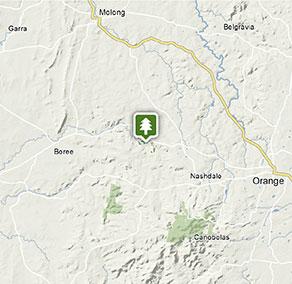Borenore Karst Conservation Reserve
Visitor info
All the practical information you need to know about Borenore Karst Conservation Reserve.
Getting there and parking
Get driving directions
From Orange:
- Take the Forbes Road (also known as the Escort Way) towards Forbes
- Take the signposted turnoff to Borenore Karst Conservation Reserve just past the town of Borenore
Park entry points
- Borenore Karst access See on map
Parking
- Borenore picnic area See on map
Road quality
- Sealed roads
Vehicle access
- 2WD vehicles
Weather restrictions
- All weather
By bike
Check out the Bicycle information for NSW website for more information.
Best times to visit
There are lots of great things waiting for you in Borenore Karst Conservation Reserve. Here are some of the highlights.
Autumn
Let your inner geologist loose among the limestone and see if you can spot the remnants of marble quarries and mines from the past.
Spring
Check out the wildflowers and birds in the endangered box gum woodland.
Summer
Escape the heat and step into magical Arch Cave while walking the Arch Cave loop track.
Weather, temperature and rainfall
Summer temperature
Average
15°C and 25°C
Highest recorded
38.3°C
Winter temperature
Average
2°C and 12°C
Lowest recorded
-5.6°C
Rainfall
Wettest month
August
Driest month
April
The area’s highest recorded rainfall in one day
98.6mm
Facilities
Maps and downloads
Prohibited
Pets
Pets and domestic animals (other than certified assistance animals) are not permitted. Find out which regional parks allow dog walking and see the pets in parks policy for more information.
Smoking
NSW national parks are no smoking areas.

Contact
- in the Country NSW region
Borenore Karst Conservation Reserve is open 9am to 7pm every day but may have to close at times due to poor weather or fire danger.
-
-
Bathurst office
02 6332 7640
02 6332 7680 To contact the KARST Conservation Unit in this office.
Contact hours: Monday to Friday, 8.30am to 4.30pm. - Level 2, 203-209 Russell Street, Bathurst NSW 2795
-
Email: npws.centralwest@environment.nsw.gov.au
-
Bathurst office
Nearby towns
Orange (17 km)
The bustling city of Orange, with its many cafes, restaurants and shopping opportunities, has something for everyone, plus there's a huge range of places to stay. The real highlight is the town's food and wine, so bring your thirst and your appetite.
Molong (28 km)
Follow the heritage walking tour of Molong in Country NSW to see the many fine 19th-century buildings. Wander through craft shops or art galleries and visit nearby historic villages such as Yeoval, Cumnock and Cudal.
Canowindra (58 km)
In the red countryside of Canowindra, you can travel back 360 million years to see rare fossils in the amazing Age of Fishes Museum, where you'll encounter thousands of fossilised freshwater fish.